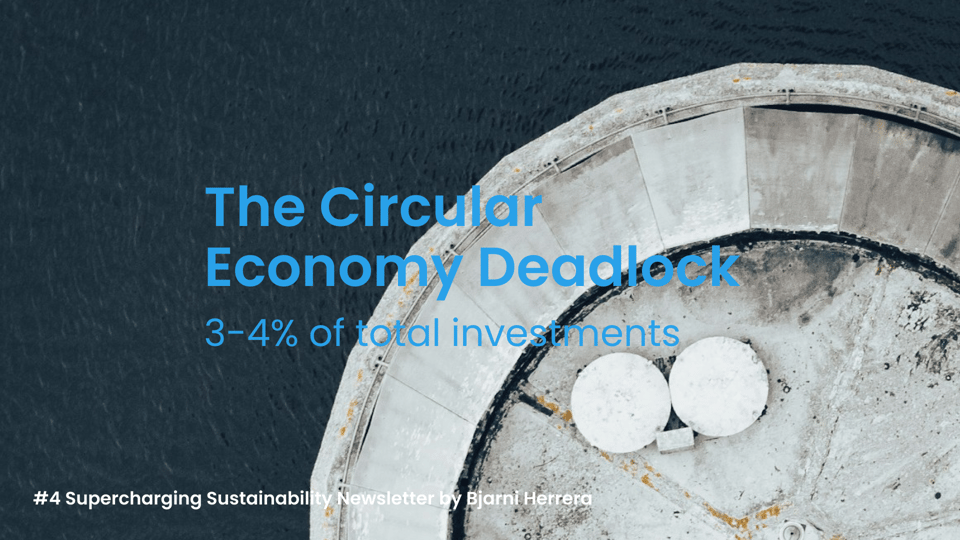Would you rather invest in a project that saves 0.5 or 5 tonnes of CO2? Would you be willing to...
How leaders navigate circular economy deadlock: a 4.5 trillion dollar opportunity
Investing in circular economy solutions and business models is still considered high risk for financiers.

Welcome to Supercharging Sustainability — my monthly newsletter featuring insights on sustainability, ESG 2.0, and sustainable finance for non-experts and experts. Here, you will find a blend of strategic insights, case studies, best practices, recent developments, personal anecdotes, and practical tips.
Enjoying the content?
You can now subscribe to receive insights directly to your inbox.
How leaders navigate circular economy deadlock: a 4.5 trillion dollar opportunity
Business leaders face a perplexing challenge in boardrooms across industries: while the circular economy promises a USD 4.5 trillion opportunity, investment levels remain stubbornly low at just 3-4% of total investments across all mechanisms—from sustainable bonds to government spending and corporate investment. Recent research from Finland (Timilsina et al. 2024) reveals a stark reality: senior managers consistently cite organisational rigidity and knowledge gaps as primary barriers to circular economy implementation. This organisational deadlock is reflected in our broader economy, which has become less circular, as the share of secondary materials in the economy has declined from 9.1% in 2018 to 7.2% in 2023.
Drawing from my extensive work in circular economy financing and organisational transformation, I've observed a consistent pattern: while access to capital matters, the most successful transitions happen when leaders effectively address financial and organisational barriers together. Having advised financial institutions and corporations on circular economy implementation, I've seen firsthand that unlocking this opportunity requires a fundamental shift in how leaders think about and manage change.

The implementation challenge: beyond good intentions
The journey from recognising circular economy opportunities to implementing them reveals a complex web of barriers. The Finnish research surveyed 41 pioneering circular economy companies in Finland and provides valuable insights into why companies hesitate to embrace circularity despite its clear benefits. The study identifies several significant internal barriers, with resource limitations, organisational rigidity, and knowledge gaps emerging as the primary challenges. Financial sustainability remains a fundamental concern, with the "lack of financial support and control" affecting companies' willingness to invest in circular initiatives.
According to this study, companies face substantial external obstacles, particularly legal restrictions and intense price competition in traditional markets. These findings align with broader industry patterns, where even organisations committed to circular principles often struggle with practical implementation.

These findings align with my experiences advising organisations on sustainable transformation. One pattern I've consistently observed is that the technical challenges of implementing circular principles often mask deeper organisational and cultural barriers. The study confirms this, with one respondent noting that "there is internal resistance in large companies, and some want to act as they have always acted before."
Risk, return, and reality: the financial perspective
The financial sector's hesitation toward investments in the circular economy stems from several interconnected factors. Traditional risk assessment models, built on historical data, struggle to evaluate circular business models accurately. This creates a problematic cycle: without adequate risk assessment frameworks, investments remain limited, and without investments, there is insufficient data to build better risk models.
However, recent research challenges this conservative stance. A 2021 analysis of 222 European companies across 14 industries reveals that circular economy adoption is an effective de-risking strategy that reduces default risk and drives superior risk-adjusted returns. Within this study, companies with stronger circular practices demonstrated a lower probability of default and achieved superior risk-adjusted stock returns. This finding suggests that our current risk assessment frameworks might be missing crucial elements of long-term business resilience.
Moving forward: bridging the investment gap
Investing in circular economy solutions and business models is still considered high risk for financiers. Financial institutions currently struggle to evaluate these opportunities properly because traditional risk models aren't equipped to price linear risks or reward the positive impact of circular initiatives. This challenge is compounded by the lack of historical data on circular business models, leaving risk committees to navigate unfamiliar territory without established benchmarks.
However, the Finnish research reveals an encouraging shift in how business leaders view the transition to circularity. Rather than focusing solely on competitive pressures, leaders increasingly recognise the importance of interconnected drivers. They emphasise that successful circular implementation requires synchronised progress across multiple fronts—from technological development to government support and capacity building. As highlighted by Accrona, scaling investment in the circular economy also depends on addressing systemic barriers and mobilising innovative financial strategies, such as those demonstrated by green industrial parks that foster industrial symbiosis and optimise resource use.
-
Evolution of risk frameworks: Financial institutions must develop more sophisticated models that capture linear risks and circular opportunities, incorporating factors like resource scarcity and regulatory trends into their assessments.
-
Regulatory clarity: Policy frameworks must provide clear, enforceable standards that create certainty for businesses, particularly SMEs that often lack resources for complex regulatory navigation.
-
Financial sector capacity building: The industry needs to develop expertise in assessing and financing circular business models on an ongoing basis, supported by knowledge sharing across institutions.
These steps can help organisations move beyond merely viewing circularity as a risk management exercise and instead see it as a strategic opportunity for long-term value creation. The key lies in building the capabilities and frameworks to support this transition effectively.
.jpg?width=1920&height=1439&name=ivan-bandura-Wwn_n0mgs7o-unsplash%20(1).jpg)
Conclusion
The circular economy's potential remains largely untapped, not due to a lack of opportunity but rather complex implementation and risk assessment barriers. However, some evidence suggests that organisations successfully navigating these challenges are building more resilient and profitable businesses. Despite this improved resiliency and profitability, the investment gap remains stubbornly low, and circularity globally is receding.
The transition to a circular economy represents one of our time's most significant economic opportunities. While the challenges are real, they are not insurmountable. We can close the gap between the circular economy's promise and its current reality by addressing practical and perceptual barriers.
I invite you to share your thoughts and experiences in the comments below. Subscribe to Supercharging Sustainability to join our growing community of professionals working to accelerate the transition to a more sustainable economy.
Let's continue the conversation
This newsletter was first published on LinkedIn where I invite my subscribers to join the conversation and share their thoughts and opinions. To never miss out on updates like this, sign up here and subscribe on LinkedIn to share your thoughts.


